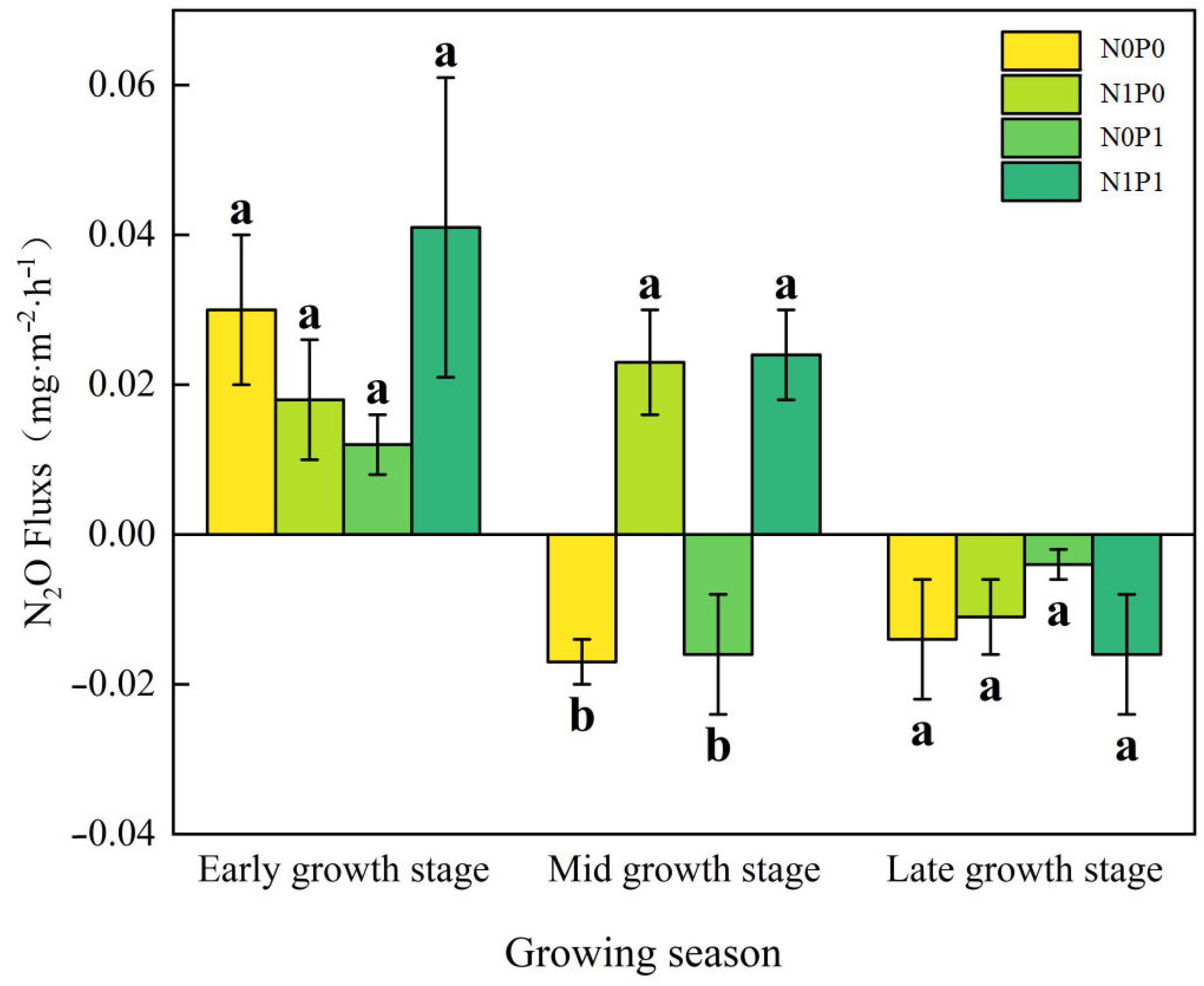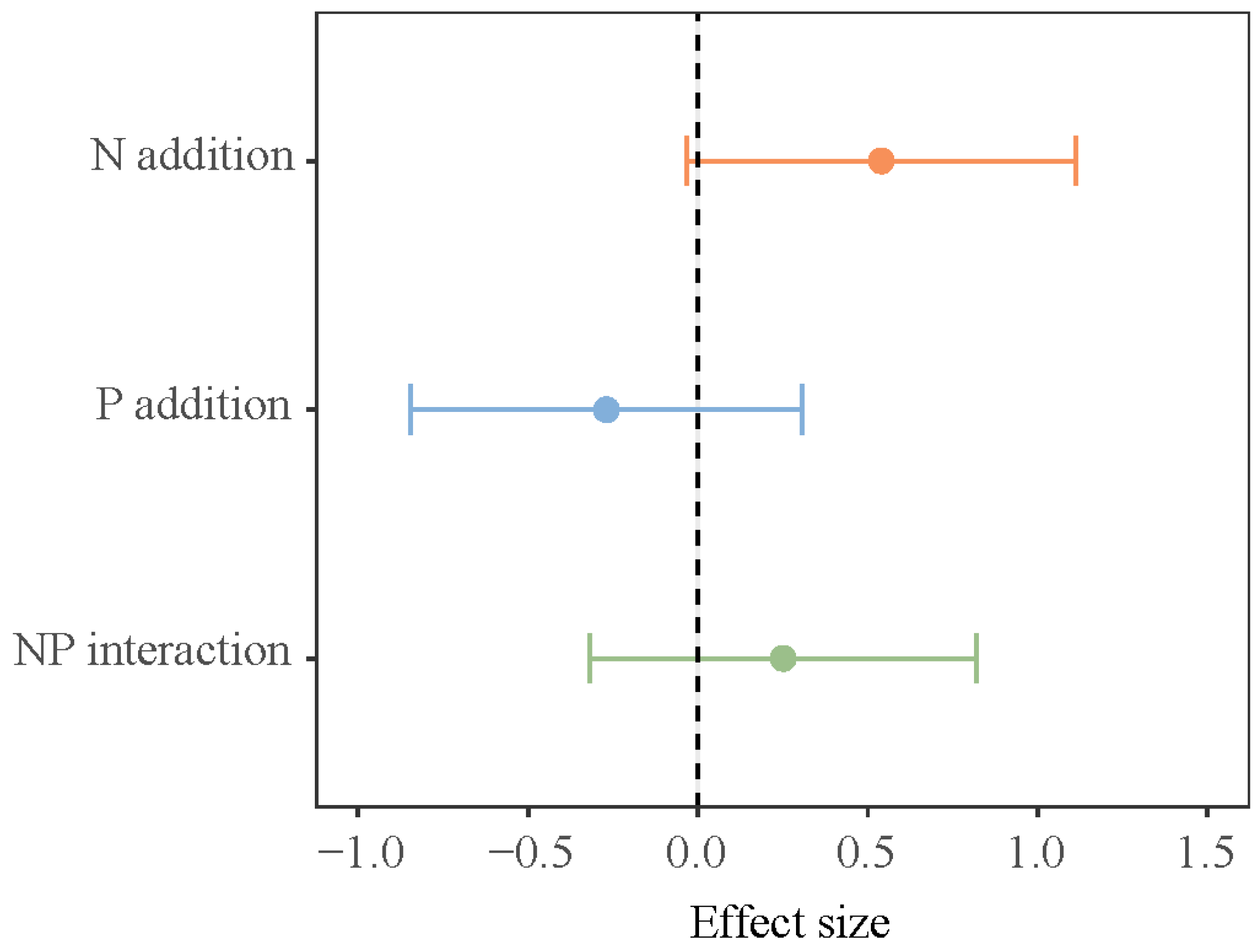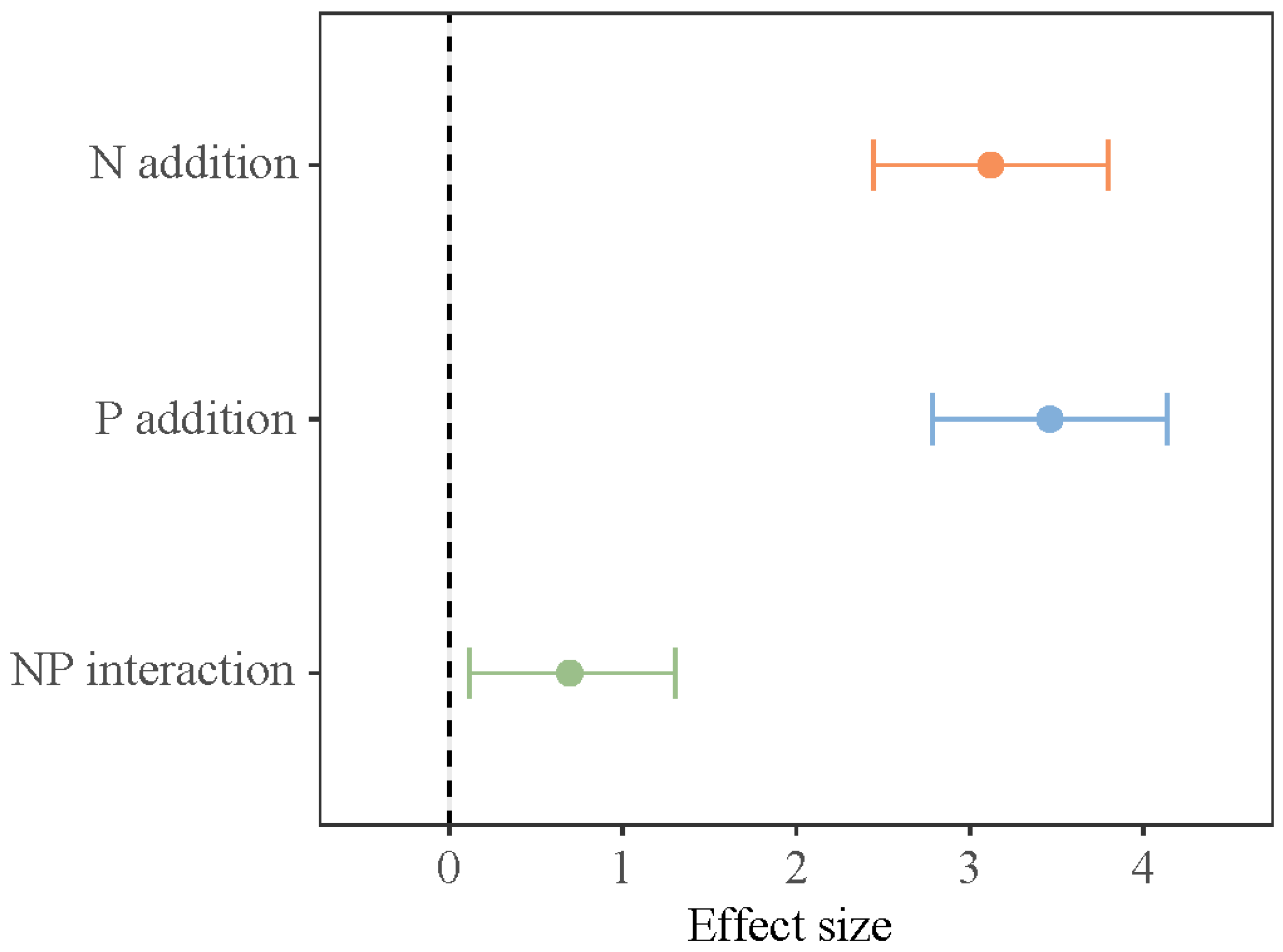Effects of Nitrogen and Phosphorus Additions on Soil N2O Emission and Soil Carbon Storage in Lakeshore Zone
Abstract
1. Introduction
2. Materials and Methods
2.1. Overview of the Experimental Site
2.2. Experimental Design
2.3. Measurement of Gas, Soil, and Environmental Factors
2.3.1. Measurement of N2O Flux
2.3.2. Soil Sampling and Analysis
2.4. Data Processing and Analysis
2.5. Interactive Effects
3. Results
3.1. Effects of Short-Term N and P Additions on N2O Flux
3.2. Effects of Short-Term N and P Additions on SOC Storage
3.3. Correlation Analysis of Soil N2O Flux, SOC Storage, and Soil Physicochemical Factors Under N and P Additions
3.4. Effects of Short-Term N and P Additions on Carbon Sequestration Benefits During the Growing Season
4. Discussion
5. Conclusions
6. Limitations and Future Prospects
Author Contributions
Funding
Institutional Review Board Statement
Informed Consent Statement
Data Availability Statement
Acknowledgments
Conflicts of Interest
References
- Lal, R. Soil Carbon Sequestration Impacts on Global Climate Change and Food Security. Science 2004, 304, 1623–1627. [Google Scholar] [CrossRef] [PubMed]
- Amaral, V.; Ortega, T.; Romera-Castillo, C.; Forja, J. Linkages between Greenhouse Gases (CO2, CH4, and N2O) and Dissolved Organic Matter Composition in a Shallow Estuary. Sci. Total Environ. 2021, 788, 147863. [Google Scholar] [CrossRef] [PubMed]
- Ji, K.; Ouyang, W.; Lin, C.; He, M.; Liu, X. Eco-Hydrological Processes Regulate Lake Riparian Soil Organic Matter under Dryness Stress. Water Res. 2024, 260, 121938. [Google Scholar] [CrossRef] [PubMed]
- Yang, Z.; Zhao, Y.; Xia, X. Nitrous Oxide Emissions from Phragmites Australis-Dominated Zones in a Shallow Lake. Environ. Pollut. 2012, 166, 116–124. [Google Scholar] [CrossRef]
- Chen, H.; Yu, Z.; Wu, N.; Wang, Y.; Liu, X. “C-Wetland”: A New Paradigm to Enhance Conservation of Carbon-Rich Wetlands. Innovation 2023, 4, 100403. [Google Scholar] [CrossRef]
- Dai, T.; Liu, R.; Zhou, X.; Zhang, J.; Song, M.; Zou, P.; Bi, X.; Li, S. Role of Lake Aquatic–Terrestrial Ecotones in the Ecological Restoration of Eutrophic Water Bodies. Toxics 2023, 11, 560. [Google Scholar] [CrossRef]
- Zhuo, Y.; Zeng, W. Using Stable Nitrogen Isotopes to Reproduce the Process of the Impact of Human Activities on the Lakes in the Yunnan Guizhou Plateau in the Past 150–200 Years. Sci. Total Environ. 2020, 741, 140191. [Google Scholar] [CrossRef]
- Wang, M.; Jiang, T.; Mao, Y.; Wang, F.; Yu, J.; Zhu, C. Current Situation of Agricultural Non-Point Source Pollution and Its Control. Water Air Soil Pollut. 2023, 234, 471. [Google Scholar] [CrossRef]
- Ongley, E.D.; Xiaolan, Z.; Tao, Y. Current status of agricultural and rural non-point source Pollution assessment in China. Environ. Pollut. 2009, 158, 1159–1168. [Google Scholar] [CrossRef]
- Marschner, H. Andy Meharg Marschner’s Mineral Nutrition of Higher Plants. Exp. Agric. 2012, 48, 305. [Google Scholar] [CrossRef]
- Shen, Y.; Zhu, B. Effects of Nitrogen and Phosphorus Enrichment on Soil N2O Emission from Natural Ecosystems: A Global Meta-Analysis. Environ. Pollut. 2022, 301, 118993. [Google Scholar] [CrossRef] [PubMed]
- Wolf, I.; Russow, R. Different Pathways of Formation of N2O, N2 and NO in Black Earth Soil. Soil Biol. Biochem. 2000, 32, 229–239. [Google Scholar] [CrossRef]
- Zhu, X.; Luo, C.; Wang, S.; Zhang, Z.; Cui, S.; Bao, X.; Jiang, L.; Li, Y.; Li, X.; Wang, Q.; et al. Effects of Warming, Grazing/Cutting and Nitrogen Fertilization on Greenhouse Gas Fluxes during Growing Seasons in an Alpine Meadow on the Tibetan Plateau. Agric. For. Meteorol. 2015, 214–215, 506–514. [Google Scholar] [CrossRef]
- Ma, W.; Jiang, S.; Assemien, F.; Qin, M.; Ma, B.; Xie, Z.; Liu, Y.; Feng, H.; Du, G.; Ma, X.; et al. Response of Microbial Functional Groups Involved in Soil N Cycle to N, P and NP Fertilization in Tibetan Alpine Meadows. Soil Biol. Biochem. 2016, 101, 195–206. [Google Scholar] [CrossRef]
- Gao, Y.; Chen, H.; Schumann, M.; Wu, Y.; Zeng, X. Short-Term Responses of Nitrous Oxide Fluxes to Nitrogen and Phosphorus Addition in a Peatland on the Tibetan Plateau. Environ. Eng. Manag. J. 2015, 14, 121–127. [Google Scholar] [CrossRef]
- Sommerfeld, R.; Mosier, A.; Musselman, R. CO2, CH4 and N2O flux through a Wyoming snowpack and implications for global budgets. Nature 1993, 361, 140–142. [Google Scholar] [CrossRef]
- Xu, Y.; Zhao, Y.; Cha, X.; Yang, W.; Zheng, M.; Liu, S.; Wang, Y.; Cai, A.; Han, X.; Yang, G.; et al. Nitrogen Addition-Driven Soil Organic Carbon Stability Depends on the Fractions of Particulate and Mineral-Associated Organic Carbon. Nutr. Cycl. Agroecosyst. 2024, 128, 269–281. [Google Scholar] [CrossRef]
- Tang, B.; Rocci, K.S.; Lehmann, A.; Rillig, M.C. Nitrogen Increases Soil Organic Carbon Accrual and Alters Its Functionality. Glob. Chang. Biol. 2023, 29, 1971–1983. [Google Scholar] [CrossRef]
- Wang, R.; Bicharanloo, B.; Hou, E.; Jiang, Y.; Dijkstra, F.A. Phosphorus Supply Increases Nitrogen Transformation Rates and Retention in Soil: A Global Meta-Analysis. Earth Future 2022, 10, e2021EF002479. [Google Scholar] [CrossRef]
- Feng, J.; Zhu, B. A Global Meta-Analysis of Soil Respiration and Its Components in Response to Phosphorus Addition. Soil Biol. Biochem. 2019, 135, 38–47. [Google Scholar] [CrossRef]
- Liu, B.; Wu, R.; Xue, B.; Gao, R.; An, H.; Liu, L.; Ndzana, G.M.; Du, L.; Kamran, M. Effects of Nutrient Addition on the Composition and Chemical Characteristics of Soil Dissolved Organic Matter in a Desert Steppe in Northern China. Land Degrad. Dev. 2024, 35, 1365–1380. [Google Scholar] [CrossRef]
- Liu, Y.; Zang, H.; Ge, T.; Bai, J.; Lu, S.; Zhou, P.; Peng, P.; Shibistova, O.; Zhu, Z.; Wu, J.; et al. Intensive Fertilization (N, P, K, Ca, and S) Decreases Organic Matter Decomposition in Paddy Soil. Appl. Soil Ecol. 2018, 127, 51–57. [Google Scholar] [CrossRef]
- Turner, B.L.; Yavitt, J.B.; Harms, K.E.; Garcia, M.N.; S. Wright, J. Seasonal Changes in Soil Organic Matter after a Decade of Nutrient Addition in a Lowland Tropical Forest. Biogeochemistry 2015, 123, 221–235. [Google Scholar] [CrossRef]
- Tenuta, M.; Mkhabela, M.; Tremorin, D.; Coppi, L.; Phipps, G.; Flaten, D.; Ominski, K. Nitrous Oxide and Methane Emission from a Coarse-Textured Grassland Soil Receiving Hog Slurry. Agric. Ecosyst. Environ. 2010, 138, 35–43. [Google Scholar] [CrossRef]
- Yin, G.; Hou, L.; Liu, M.; Li, X.; Zheng, Y.; Gao, J.; Jiang, X.; Wang, R.; Yu, C.; Lin, X. DNRA in intertidal sediments of the Yangtze Estuary. J. Geophys. Res. Biogeosci. 2017, 122, 1988–1998. [Google Scholar] [CrossRef]
- Wang, H.; Huang, W.; He, Y.; Niu, Y.; Zhu, Y. Effects of short-term warming and precipitation reduction on soil microbial biomass carbon, nitrogen and enzyme activity in sandy grassland. J. Desert Res. 2022, 42, 274–281. [Google Scholar]
- Zhou, H.; Yu, W.; Ma, Q.; Zhang, L. A Modified Fumigation Extraction Method for the Determination of Soil Microbial Biomass Carbon. Chin. J. Soil Sci. 2009, 40, 154–157. [Google Scholar]
- Sato, J.H.; de Figueiredo, C.C.; Marchão, R.L.; Madari, B.E.; Benedito, L.E.C.; Busato, J.G.; de Souza, D.M. Methods of Soil Organic Carbon Determination in Brazilian Savannah Soils. Sci. Agric. 2014, 71, 302–308. [Google Scholar] [CrossRef]
- Jiang, S. Review on soil bulk density determination method. J. Hubei Agric. Sci. 2019, 58, 82–86. [Google Scholar] [CrossRef]
- Ma, Y.; Feng, S.; Huang, Q.; Liu, Q.; Zhang, Y.; Niu, Y. Distribution characteristics of soil carbon density and influencing factors in Qinghai–Tibet Plateau region. Env. Geochem. Health 2024, 46, 152. [Google Scholar] [CrossRef]
- Crain, C.M.; Kroeker, K.; Halpern, B.S. Interactive and cumulative effects of multiple human stressors in marine systems. Ecol. Lett. 2008, 11, 1304–1315. [Google Scholar] [CrossRef] [PubMed]
- Zhou, L.Y.; Zhou, X.H.; Shao, J.J.; Nie, Y.Y.; He, Y.H.; Jiang, L.L.; Wu, Z.T.; Bai, S.H. Interactive effects of global change factors on soil respiration and its components: A meta-analysis. Glob. Chang. Biol. 2016, 22, 3157–3169. [Google Scholar] [CrossRef] [PubMed]
- Tian, H.; Xu, R.; Canadell, J.G.; Thompson, R.L.; Winiwarter, W.; Suntharalingam, P.; Davidson, E.A.; Ciais, P.; Jackson, R.B.; Maenhout, G.J.; et al. A Comprehensive Quantification of Global Nitrous Oxide Sources and Sinks. Nature 2020, 586, 248–256. [Google Scholar] [CrossRef] [PubMed]
- Lu, X.; Wen, L.; Sun, H.; Fei, T.; Liu, H.; Ha, S.; Tang, S.; Wang, L. Responses of Soil Respiration to Phosphorus Addition in Global Grasslands: A Meta-Analysis. J. Clean. Prod. 2022, 349, 131413. [Google Scholar] [CrossRef]
- Wang, F.; Li, J.; Wang, X.; Zhang, W.; Zou, B.; Neher, D.A.; Li, Z. Nitrogen and Phosphorus Addition Impact Soil N2O Emission in a Secondary Tropical Forest of South China. Sci. Rep. 2014, 4, 5615. [Google Scholar] [CrossRef]
- Ullah, B.; Shaaban, M.; Hu, R.; Zhao, J.; Lin, S. Assessing Soil Nitrous Oxide Emission as Affected by Phosphorus and Nitrogen Addition under Two Moisture Levels. J. Integr. Agric. 2016, 15, 2865–2872. [Google Scholar] [CrossRef]
- Cui, Q.; Song, C.; Wang, X.; Shi, F.; Wang, L.; Guo, Y. Rapid N2O Fluxes at High Level of Nitrate Nitrogen Addition during Freeze-Thaw Events in Boreal Peatlands of Northeast China. Atmos. Environ. 2016, 135, 1–8. [Google Scholar] [CrossRef]
- Mori, T.; Ohta, S.; Ishizuka, S.; Konda, R.; Wicaksono, A.; Heriyanto, J. Phosphorus application reduces N2O emissions from tropical leguminous plantation soil when phosphorus uptake is occurring. Biol. Fertil. Soils 2014, 50, 45–51. [Google Scholar] [CrossRef]
- Liu, Y.; Li, Y.; Wan, Y.; Gao, Z.; Qin, X.; Chen, D. Nitrous Oxide Emissions from Spring-maize Field Under the Application of Different Nitrogen and Phosphorus Fertilizers. J. Agro-Environ. Sci. 2011, 30, 1468–1475. [Google Scholar]
- Li, C.; Bai, H.; Dang, T.; Wang, W. Relationship of field soil phosphatase activity and soil N2O emission flux. China Environ. Sci. 2007, 2, 231–234. [Google Scholar]
- Bremner, J.M.; Robbins, S.G.; Blackmer, A.M. Seasonal Variability in Emission of Nitrous Oxide from Soil. Geophys. Res. Lett. 1980, 7, 641–644. [Google Scholar] [CrossRef]
- Cheng, J.; Xu, L.; Jiang, M.; Jiang, J.; Xu, Y. Warming Increases Nitrous Oxide Emission from the Littoral Zone of Lake Poyang, China. Sustainability 2020, 12, 5674. [Google Scholar] [CrossRef]
- Zhang, Y.; Zhang, N.; Yin, J.; Yang, F.; Zhao, Y.; Jiang, Z.; Tao, J.; Yan, X.; Qiu, Y.; Guo, H.; et al. Combination of Warming and N Inputs Increases the Temperature Sensitivity of Soil N2O Emission in a Tibetan Alpine Meadow. Sci. Total Environ. 2020, 704, 135450. [Google Scholar] [CrossRef] [PubMed]
- Manono, B.O. Carbon dioxide, nitrous oxide and methane emissions from the Waimate District (New Zealand) pasture soils as influenced by irrigation, effluent dispersal and earthworms. Cogent Environ. Sci. 2016, 2, 1256564. [Google Scholar] [CrossRef]
- Lan, T.; Han, Y.; Roelcke, M.; Nieder, R.; Cai, Z. Processes Leading to N2O and NO Emissions from Two Different Chinese Soils under Different Soil Moisture Contents. Plant Soil 2013, 371, 611–627. [Google Scholar] [CrossRef]
- Pastore, M.A.; Megonigal, J.P.; Langley, J.A. Elevated CO2 promotes long-term nitrogen accumulation only in combination with nitrogen addition. Glob. Chang. Biol. 2016, 22, 391–403. [Google Scholar] [CrossRef]
- Dai, Z.; Yu, M.; Chen, H.; Zhao, H.; Huang, Y.; Su, W.; Xia, F.; Chang, S.X.; Brookes, P.C.; Dahlgren, R.A.; et al. Elevated Temperature Shifts Soil N Cycling from Microbial Immobilization to Enhanced Mineralization, Nitrification and Denitrification across Global Terrestrial Ecosystems. Glob. Chang. Biol. 2020, 26, 5267. [Google Scholar] [CrossRef]
- Chen, H.; Mothapo, N.V.; Shi, W. Soil Moisture and pH Control Relative Contributions of Fungi and Bacteria to N2O Production. Microb. Ecol. 2015, 69, 180–191. [Google Scholar] [CrossRef]
- Yue, P.; Zuo, X.; Li, K.; Li, X.; Wang, S.; Ma, X.; Qu, H.; Chen, M.; Liu, L.; Misselbrook, T.; et al. Responses of Ecosystem Respiration, Methane Uptake and Nitrous Oxide Emission to Drought in a Temperate Desert Steppe. Plant Soil 2021, 469, 409–421. [Google Scholar] [CrossRef]
- Bouwman, A.F.; Fung, I.; Matthews, E.; John, J. Global Analysis of the Potential for N2O Production in Natural Soils. Glob. Biogeochem. Cycles 1993, 7, 557–597. [Google Scholar] [CrossRef]
- Tang, Y.C.; Zhang, X.Y.; Li, D.D.; Wang, H.M.; Chen, F.S.; Fu, X.L.; Fang, X.M.; Sun, X.M.; Yu, G.R. Impacts of nitrogen and phosphorus additions on the abundance and community structure of ammonia oxidizers and denitrifying bacteria in Chinese fir plantations. Soil Biol. Biochem. 2016, 103, 284–293. [Google Scholar] [CrossRef]
- Liu, L.; Greaver, T.L. A Global Perspective on Belowground Carbon Dynamics under Nitrogen Enrichment. Ecol. Lett. 2010, 13, 819–828. [Google Scholar] [CrossRef] [PubMed]
- Jiang, J.; Wang, Y.P.; Liu, F.; Du, Y.; Zhuang, W.; Chang, Z.; Yu, M.; Yan, J. Antagonistic and additive interactions dominate the responses of belowground carbon-cycling processes to nitrogen and phosphorus additions. Soil Biol. Biochem. 2021, 156, 108216. [Google Scholar] [CrossRef]
- Yue, K.; Fornara, D.A.; Yang, W.; Peng, Y.; Peng, C.; Liu, Z.; Wu, F. Influence of Multiple Global Change Drivers on Terrestrial Carbon Storage: Additive Effects Are Common. Ecol. Lett. 2017, 20, 663–672. [Google Scholar] [CrossRef] [PubMed]
- Xia, W.; Bowatte, S.; Jia, Z.; Newton, P. Offsetting N2O Emissions through Nitrifying CO2 Fixation in Grassland Soil. Soil Biol. Biochem. 2022, 165, 108528. [Google Scholar] [CrossRef]
- Guenet, B.; Gabrielle, B.; Chenu, C.; Arrouays, D.; Balesdent, J.; Bernoux, M.; Bruni, E.; Caliman, J.P.; Cardinael, R.; Chen, S.; et al. Can N2O Emissions Offset the Benefits from Soil Organic Carbon Storage? Glob. Change Biol. 2020, 27, 237–256. [Google Scholar] [CrossRef]




| Factor | Treatment | Growth Stages | Treatment × Growth Stages | |||
|---|---|---|---|---|---|---|
| F | p | F | p | F | p | |
| N2O flux | 1.167 | 0.336 | 6.687 | 0.003 | 1.172 | 0.343 |
| organic carbon storage | 4.487 | 0.018 | 5.214 | 0.004 | 2.826 | 0.023 |
| N2O Fluxs | Organic Carbon Storage | |
|---|---|---|
| organic carbon storage | 0.439 | 1 |
| pH | −0.164 | −0.504 |
| ST | 0.255 | −0.151 |
| SM | 0.130 | 0.107 |
| NO3−-N | 0.682 * | 0.521 |
| NH4+-N | 0.202 | 0.146 |
| MBC | −0.149 | −0.561 |
| MBN | 0.404 | 0.089 |
| Growth Stage | Treatment | Organic Carbon Carbon Stocks (T) kg·m−2 | CO2 (T) Equivalent ① kg·m−2 | Carbon Sequestration Benefits (T) kg·m−2 | The Change Rate of Carbon Sequestration Benefits ② % |
|---|---|---|---|---|---|
| early part of growing season | N | 0.6218 | 0.0051 | 0.6269 | 72.7 |
| P | 0.1730 | 0.0077 | 0.1807 | 20.9 | |
| NP | 0.8509 | −0.0047 | 0.8462 | 98.1 | |
| peak growing season | N | −0.4340 | −0.0172 | −0.4512 | −49.0 |
| P | −0.1757 | −0.0004 | −0.1761 | −19.1 | |
| NP | 0.5385 | −0.0176 | 0.5209 | 56.5 | |
| late growing season | N | 0.0038 | −0.0013 | 0.0025 | 0.3 |
| P | 0.3434 | −0.0043 | 0.3391 | 38.5 | |
| NP | 0.1818 | 0.0009 | 0.1827 | 20.8 |
Disclaimer/Publisher’s Note: The statements, opinions and data contained in all publications are solely those of the individual author(s) and contributor(s) and not of MDPI and/or the editor(s). MDPI and/or the editor(s) disclaim responsibility for any injury to people or property resulting from any ideas, methods, instructions or products referred to in the content. |
© 2025 by the authors. Licensee MDPI, Basel, Switzerland. This article is an open access article distributed under the terms and conditions of the Creative Commons Attribution (CC BY) license (https://creativecommons.org/licenses/by/4.0/).
Share and Cite
Qi, S.; Jia, G.; Cao, W.; Zhong, W.; Wang, Z.; Wang, L.; Liu, T.; Guo, J.; Wen, L. Effects of Nitrogen and Phosphorus Additions on Soil N2O Emission and Soil Carbon Storage in Lakeshore Zone. Sustainability 2025, 17, 5987. https://doi.org/10.3390/su17135987
Qi S, Jia G, Cao W, Zhong W, Wang Z, Wang L, Liu T, Guo J, Wen L. Effects of Nitrogen and Phosphorus Additions on Soil N2O Emission and Soil Carbon Storage in Lakeshore Zone. Sustainability. 2025; 17(13):5987. https://doi.org/10.3390/su17135987
Chicago/Turabian StyleQi, Sichen, Guoxiu Jia, Weijia Cao, Wentao Zhong, Zhenxing Wang, Lixin Wang, Tiejun Liu, Jianying Guo, and Lu Wen. 2025. "Effects of Nitrogen and Phosphorus Additions on Soil N2O Emission and Soil Carbon Storage in Lakeshore Zone" Sustainability 17, no. 13: 5987. https://doi.org/10.3390/su17135987
APA StyleQi, S., Jia, G., Cao, W., Zhong, W., Wang, Z., Wang, L., Liu, T., Guo, J., & Wen, L. (2025). Effects of Nitrogen and Phosphorus Additions on Soil N2O Emission and Soil Carbon Storage in Lakeshore Zone. Sustainability, 17(13), 5987. https://doi.org/10.3390/su17135987






